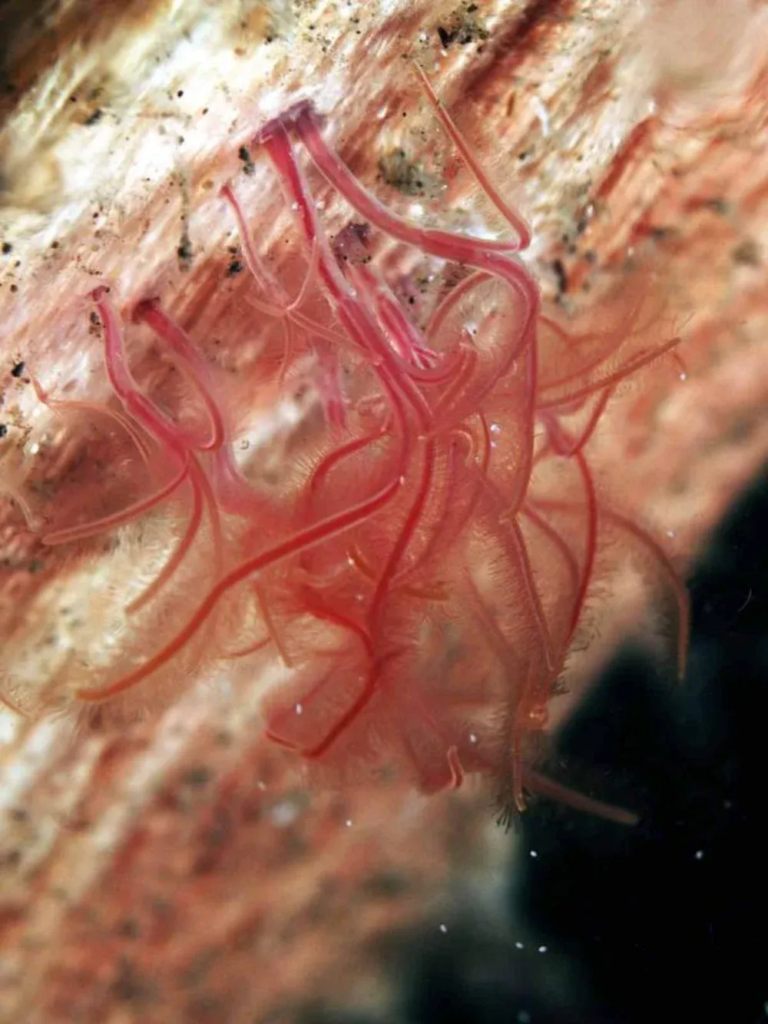If you’re leading a group of zombie apocalypse survivors, you don’t want to lose sight of the horde of brain-hungry creatures trying to eat you. The same can be said if the zombie worm Osedax goes missing from the ocean floor. Also called “the bone devourer,” the worm plays a crucial role in decomposing the bodies of larger organisms and supporting a bevy of deep-sea biodiversity. Losing them can be a major warning sign of species loss and ecosystem decline due to climate change.
How the zombie worm devours bones
First discovered in 2002, Osedax worms measure about one to three inches long. There are 26 known Osedax species and they are considered an ecosystem engineer species.
Despite not having a mouth, anus, or digestive tract, their roots bore into bones from larger marine animals like whales. They secrete an acid from their skin that dissolves the bone. Once the bone is dissolved, the fat and protein trapped inside is released. The symbiotic bacteria living on the worms’ bodies then digest the fat and protein. However, it is still unclear how Osedax gets the nutrients from that bacteria. It could be that they digest it or the nutrients are somehow transferred to the worm via some mystery mechanism.

Wormless whale fall
When studying humpback whale bones off the coast of British Columbia, University of Victoria and Oceans Networks Canada staff scientist Fabio De Leo found no evidence of this crucial worm. Through 10 years of observation, their high-resolution cameras did not pick up a single zombie worm colonization of these bones. This troubling result is called a negative result in scientific research and indicates that something is wrong.
“This was a remarkable observation in such a long-term experiment,” De Leo said in a statement, noting that the low concentrations of oxygen present at the observation site might play a role.
The whale bones were placed over 3,000 feet below the surface of the Pacific in Barkley Canyon. This naturally occurring low-oxygen zone is on one of the migration routes for humpback and grey whales that travel between Hawaii and Alaska. The whales that die from natural causes, or human threats (ship strikes, fishing gear, etc.) along the way will sink to the bottom. This creates a feeding bonanza called whale falls. The remains support ocean scavengers.
The absence of zombie worms on these bones suggests that the expanding oxygen minimum zones in the northeast Pacific and elsewhere might be disturbing these ecosystems more broadly. Preliminary data from on other whale fall research near a different site suggests that zombie worms may also be affected elsewhere.

Connected habitats
If the “bone devourer” zombie worm isn’t there to perform its ecological role, other species may be unable to colonize on the whale remains and use the critical nutrients in the whale carcass.
De Leo likens whale falls to islands that are a “stepping-stone habitat” for the worms and many other species that specialize in whale bones. Adult Osedax generally grow on whale bones and their larvae are dispersed over large distances to populate other whale fall ecosystems hundreds of miles away.
“Basically, we’re talking about potential species loss,” said De Leo. “So, this connectivity, these island habitats, will not be connected anymore, and then you could start losing a diversity of Osedax species across regional spatial scales.”
The team also found that another ecosystem engineer–Xylophaga–also appears affected by low-oxygen stress. These bivalves burrow into wood that sinks and help it decompose. While they did see Xylophaga on the experiment’s submerged wood samples, they colonized at much lower rates than in ocean areas with more oxygen.
“It looks like the OMZ [oxygen minimum zone] expansion, which is a consequence of ocean warming, will be bad news for these amazing whale-fall and wood-fall ecosystems along the northeast Pacific Margin,” added Craig Smith, a professor emeritus from University of Hawaii, who co-led the experiment.
The team will continue to monitor other sights with high-definition video and remotely operated vehicles to collect environmental data.



